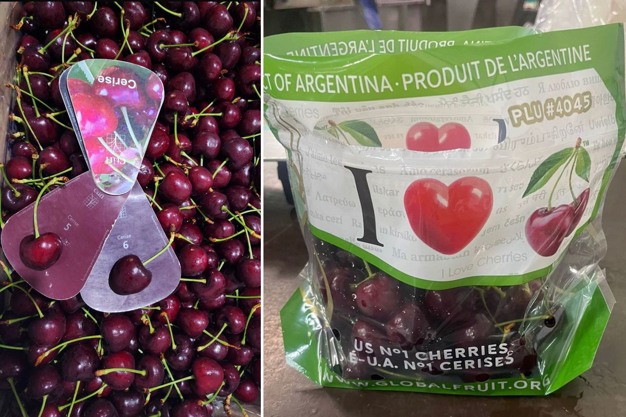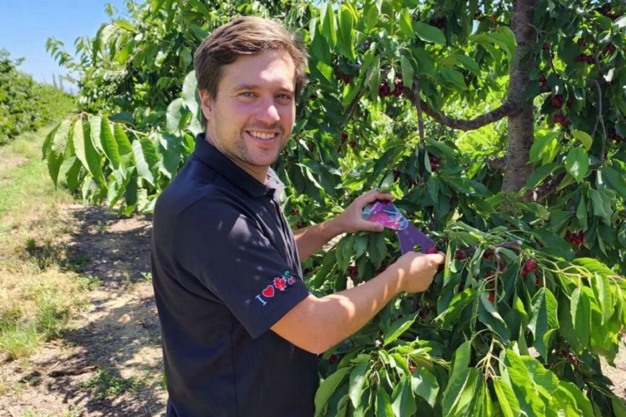Even before winter finished, British Columbia (B.C.) cherry growers knew they were going to have a very short 2024 cherry crop due to a severe freeze event in January. While the province doesn't collect statistics from growers and packers, this year's production volume was about 10 to 20 percent of an average crop. "This came on the back of four bad cherry crops in B.C. and will enter the books as the worst crop in recent memory," says Richard Isaacs with Global Fruit. Many growers decided not to harvest at all as labor costs are nearly the same for a tree that carries 50 lbs. of fruit versus a tree that carries only 10 lbs. "These growers couldn't justify the picking costs, and many left their cherries on the trees."
Short crop in volume and duration
All in all, it was a short crop in quantity as well as duration. The devastating freeze affected all cherry regions in B.C., but the northern part of the Okanagan Valley and the town of Creston got hit the hardest, and those are traditionally the areas where the latest cherries are grown. A hot and dry July with temperatures consistently above 30°C also resulted in cherries maturing faster. "In addition, small crops always tend to ripen faster as the tree has more energy to give to each individual cherry." All these circumstances combined caused the B.C. cherry harvest to end on August 17, which was about three weeks earlier than normal.
Government support
The B.C. government has recognized that tree fruit growers have been facing difficult times due to extreme weather as well as the recent closure of BC Tree Fruits Cooperative. As a result, new or updated financial support has been announced for farmers whose livelihoods depend on it. The province is enhancing its AgriStability program to raise the compensation rate to 90 percent and double the compensation cap for all farmers for the 2024 program year. This will provide an estimated $15 million in immediate relief to farmers in need. In addition, a new Tree Fruit Climate Resiliency program will provide $5 million to help tree fruit farmers buy equipment and pursue projects that were not eligible under previous programs. "This will strengthen farm resilience and preparedness for extreme weather," the B.C. government mentioned on their website.
"This support from the B.C. government is very welcome, especially the Climate Resiliency program which I hope will become an ongoing fund and not just a one-year injection," commented Isaacs. "This was a cherry season we want to forget, but it's also a season from which we can draw many lessons in order to adapt and continue in the future."

Cherries from Argentina.
Looking forward
In addition to selling and marketing B.C. cherries, Global Fruit also has partnerships with cherry growers in Chile and Argentina. "Our fourth season is coming up and we are very excited for the southern hemisphere crop," commented Isaacs. Chile and Argentina both had plenty of chill hours, enough rain and the trees look healthy with lots of buds. "Everyone is predicting a record crop for Chile," said Isaacs. "The country may ship more than 100 million 5 kg cartons." Compared to Chile, Argentina's cherry volume is much lower but having geographic spread is critical to ensure consistent high-quality supply with a crop as volatile as cherries. Both countries have the same harvest window, starting at the end of October, early November. "We run programs from Chile and Argentina simultaneously, launching the season with airfreight and then moving to ocean freight, with the latest containers from Los Antiguos, Argentina arriving in March."
Export markets
Global Fruit started marketing cherries out of South America three years ago and will continue to build on the program. "At the time, we identified an opportunity to develop a model that focuses on a short supply chain with the right fruit arriving at the right time," Isaacs mentioned. Global Fruit's team is on the ground in Chile and Argentina to make sure only high-quality fruit makes its way over to North America, Asia, and Europe, the key export destinations. "The Chilean industry has always been very focused on China, and it is fair to say that the cherries packed for other markets haven't always been the best. Consumers in North America know how cherries should look and taste because they enjoy them from the US and Canada every summer. Our supply chain model means we are now meeting those same quality standards in the winter months. Too often in the past the cherries on retail shelves during the winter meant a high shrink rate at store level and low repeat purchase numbers. Our approach is reversing that trend for our retail partners and driving more consumption between November and March."
Developing markets outside China is critical. In previous years, approximately 90 percent of Chile's cherry crop went to China with thousands of containers being shipped every week during the season. However, with a record crop year coming up and Chinese New Year (CNY) being early in 2025, a large portion of Chile's cherry crop may not make it in time for CNY. "It will be key to send fruit to markets outside China this upcoming season, and we are currently making programs with growers, packers and retail partners so all stakeholders come out winning in the end."

Global Fruit's Marcos Bala in a Chilean cherry orchard last season.
 For more information:
For more information:
Richard Isaacs
Global Fruit
Tel: (+1) 250-428-2320
[email protected]
www.globalfruit.org










